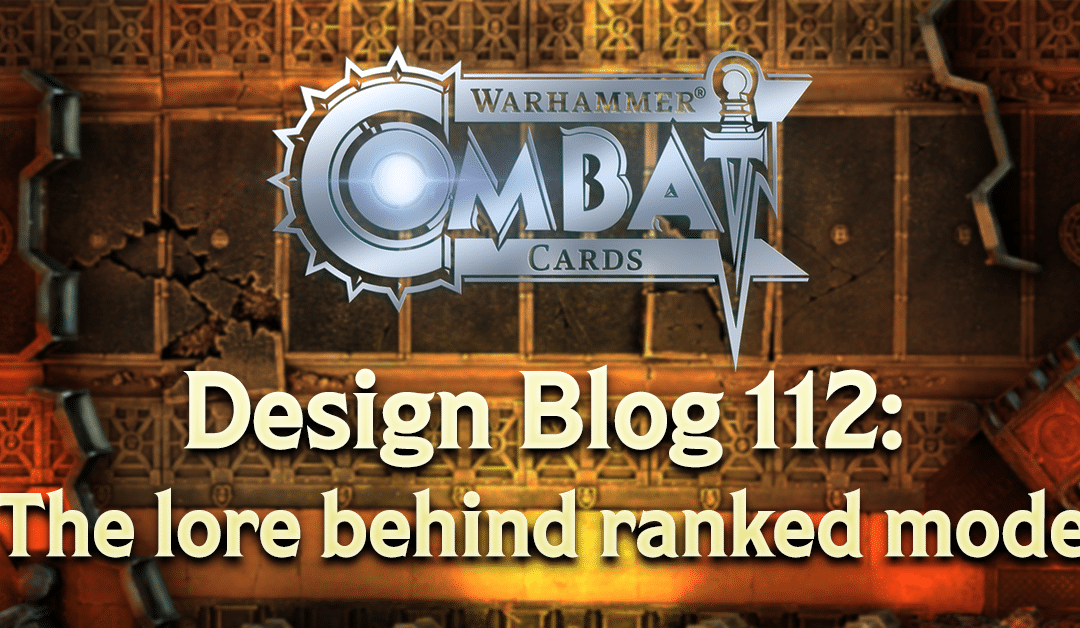This week I thought I’d talk about lore, which for the purposes of this post is all the text in Combat Cards that doesn’t strictly pass on ‘game information’. Or to put it another way, lore, as the saying goes, is like pornography – you know it when you see it.
Now I’ve put that image in your head, I specifically wanted to talk about why we include lore in the game, especially as I mentioned it doesn’t pass on any ‘game’ information.

Opportunities
Let’s take ranked mode as an example. If you tap the icon to see the ladder you climb by winning ranked battles you’re told the score needed for each step of the ladder alongside the rewards you’ll receive now and at the end of the season. But alongside that you get lore – specifically around locations from the Warhammer 40,000 universe. So rather than saying ‘stage 1a, stage 1b, stage 2a’, etc. we have several locations on Fenris, home of the Space Wolves.
But the question still stands – why do we bother with the extra step of dressing these elements with lore? After all, the work to decide what to include, write the text, find appropriate artwork, request high res art from Games Workshop and their feedback on the text, and then implement all that into the game does have a cost.
It might sound mercenary, but everything we add to the game has an ‘opportunity cost’, which means if we’re working on ‘A’ then we can’t be working on ‘B’. As a result, if a piece of work can’t be shown to have some benefit to players (such as fixing a bug) or to us (such as an improved tool) then we need to question whether that work should be done at all.

Stabby
But I think lore does provide a benefit; it makes this a Warhammer 40,000 game as opposed to just a card game. I mean the gameplay would work just as well if the buttons were labelled ‘attack 1, attack 2, attack 3’ and all the cards just had a number instead of art to tell them apart. Lore is the secret ingredient that ties this game into tabletop 40K and the entire 40K universe. Now when Ahriman blasts one of your cards with his special rule it’s the will of Tzeentch, and that’s not just card 0213 it’s Sly Marbo, terrifying stabby Catachan.
It also helps provides context for fans of the 40K universe. For instance, when you work out that the ranked mode ladder steps are working their way through our solar system it’s obvious that the final, most prestigious location will be Terra (and that the Emperor’s throne-room will be the last location within that).
Lore also provides context for things like the Campaigns and Missions, helping to explain why faction 1 is fighting faction 2, and occasionally letting people go ‘I remember that lore from a battle report in White Dwarf’. Again, no tangible benefit for this lore being there, but it’s always nice to know you’re helping the Sisters of Battle beat up the filthy Xenos of the Hive Fleets.
Finally, the lore on the back of the cards is there to help players who don’t know the ins-and-outs of every single 40K character by providing some info on who they are, what they’re armed with, why they’ve got a skull for a head, and that sort of thing. You might not need to know this stuff, but everyone has to start somewhere in the hobby, right?

Conclusion
Don’t worry, this post isn’t some bizarre cry for players to ‘appreciate the lore’! I’m confident it adds value to the game and we have no plans to strip it back. However, I would be interested to hear if anyone has any opinions on the lore we include for Campaigns / Missions, ranked mode, the back of cards, etc. Too much, not enough, needs more Skumbo? Hopefully we’ve shown by now that player opinion matters, so we’re interested to know what you think.
You can get in touch by leaving a comment below, through our Facebook page or by mailing [email protected]. Also, if you’d like to follow our posts through RSS you can use this link: https://www.combatcards.com/feed/
Thanks,
Stu

The “Lore” of the 40k universe is the reason why I downloaded this game in the first place. I wanted a new card game to play. There are many options in that genre. However, since I used to play 40k so much and read the novels, this game stood out above the rest.
Having the lore in the game keeps the 40k “aura” around your events. I think you put just the right amount.
In addition, you could use the lore to add gameplay mechanics as well. As an example, if I am playing a chaos deck, and I choose Ahriman and all Tzeentch bodyguards, why not some psychic bonus? Or if I choose all Ultramarines, maybe there should be some tactical bonus like a 50/50 chance to have a random card “ready” every turn. It is part of the lore for certain units to stick together (and to almost never fight together, like Tzeentch and Khorn armies).
I am not suggesting you guys should include those *specific* mechanics. I am just saying there is opportunity for lore to drive some of the mechanics if you so choose.
Thanks for the feedback.
Re. specific mechanics like that, we’re all getting excited about the rework to our battle system that’s going on right now. When it’s complete it will let us easily add new traits + Warlords, fix several issues with Warlord special rules, and let us play with new game modes and other ‘twists’ on the gameplay (with all of that based on lore of course).
You da man Stu!
Hello! That was a really funny one and I still appreciate these communication efforts you guys do!
Sometime I feel like the campaign mode lore could be more adequate to what is happening in-game during campaign battle. Well in fact let me twist this : what is happening in-game during campaign mode should be more reflective of the actual lore attached to it. Of course no example come to my mind right now… But I have felt this a few time in the past. I have one example : once the lore was about “random vilain faction”, nids I think, attacking an imperial fists fortress. Yeah the one where we won Tor Garadon and Sgt. Lysor. Well I suddenly felt sad to many chapters BUT Imperial Fists guys. I know there are only 3 Imperial Fists cards right now but if the lore has to talk about Ultramarine, then I would appreciate to see only Ultramarines in campaign decks. I hope Im clear enough haha. The same way we have a special tag which adds x % to our score maybe the ennemy could have 1 or 2 tags for both “army cohesion” and visual pleasure.
Which brings me to another idea : change the lore step by step as you/we progress through the campaign. Every time you unlock a new reward the lore could change so that it feels like the war is kind of evolving (even if we are fighting for a certain death haha). The lore written on the “campaigns” section would always be the same general explanation of that war and the “missions” section would be the one evolving. I don’t know how much people are responsive and apreciating the lore so that might or might not be worth the effort. I believe it would be awesome.
As a general answer : lore itself brought me back to the warhammer 40k universe and also brought me to this game so yeah I do appreciate the effort that you guys put into lore.
Half off-topic : I would really love to see new battle backgrounds! Not only faction specific background. If it’s too much maybe it could be a new background only for the… campaign mode, to add more depth to it and to make it fit the lore you have chosen to put in.
Keep up the great work on that pocket game
Hi, thanks for the feedback and suggestions.
We’re considering making our ‘Campaign bonuses’ more specific as we go forward, but we need to avoid forcing every player into using the exact same deck for the whole Campaign. For instance, if we said ‘Blood Angels’ get bonuses then technically players can make a deck themed around that but it’s not much fun if every player is more or less forced to use that same deck to get the bonuses.
Re. changing the lore as the Campaign goes on, we discussed this as well and it’s something we’d like to try as an experiment (at least to see if players respond to the extra lore). However it would be a bit of a pain for us to set up right now so will need to wait for behind the scenes improvements to how we put Campaigns and Missions together.
correction, one word is missing : “I suddenly felt sad to SEE every chapter BUT Imperial Fists.”
Love the lore keep it coming! One (hopefully) easy thing I’d like to see is to be able to expand the campaign artwork to full screen so we can visualize the battles more. Being able to zoom on cards would be cool too, or swipe to see different angles – sometimes I can’t tell if a weapon is a sword or an axe or whatever. Love the game, just joined the discord happy to be here!!
Hi, thanks for the feedback. Like you we’d love to have the full Campaign images but unfortunately that would increase the memory footprint of the game a lot. Because of all the high res card photos we already know we’ll need to look at reducing the game’s size in the future, so adding huge images wouldn’t help!
Our artists are always looking at ways of adding polish (they’re redoing the trait and special rule effects right now), so I’ll pass your requests for zooming, etc. on to them.
Dear devs,
Could you please checking the cheaters of campaigns? Only needs a little script, if your points higher than maximum than you are win the banhammer. Or losing x points. Or something.
Hi, I’ve passed your request on to our coders!